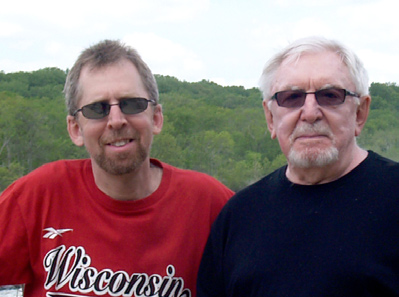| |
 |
|
|
|
|
| |
Dr. Eric Green (l) with his dad, Dr. Maurice Green |
|
When Dr. Eric Green visited his hometown St. Louis on Sept. 23, he performed a rare scholarly
honor and a son’s pleasure: He delivered the first lecture named for his father, Dr. Maurice
Green, professor of molecular virology and chairman of the Institute for Molecular Virology
at St. Louis University Medical School. Eric is scientific director at the National Human Genome Research Institute.
It crossed Eric’s mind that some might construe his father’s recommendation for the inaugural Maurice Green Lecture as nepotism. The elder Green explains his choice as a logical one, contending that his son “is the natural choice. He has unbelievable insights, he’s fun and he’s a spokesman for the future of human genomics.”
Still active in the field of virology at 82, Maurice is noted for his early studies that introduced breakthrough techniques and concepts in experimental virology. For example, his work on the molecular biology
of adenoviruses and the adenovirus oncogenes showed they are not involved in human cancer although they readily
cause cancer experimentally in rodents. In 1972, he was invited to NIH to deliver the R.E. Dyer lecture for his career contributions to medical and biological knowledge of infectious diseases.
Today Maurice explores the molecular function of the human adenovirus E1A oncogene, which has implications for breast cancer treatment. “I deal with viruses and their interaction with human genes and the cell,” he explained. He is convinced that genomics holds the key to future biomedical discoveries in this area. Eric’s talk, titled “Fulfilling the Promise of a Sequenced Human Genome,” provided a “big picture view” of where genomics is headed in the future. He offered examples of his research, which involves interpreting the human genome sequence and applying large-scale DNA sequencing to clinical research projects.
As a boy, Eric was hired by his father to send out reprints of his father’s journal articles requested from scientists around the world. “I thought it was a cool job—first because I got paid, but also for the opportunity to collect international stamps.” Although he was handling
some of the seminal papers in virology, the young Green wasn’t much impressed.
“I would occasionally flip through one of the reprints and think this science stuff is boring and full of gibberish. I couldn’t fathom why anyone
would read it.”
Father and son share a lifetime love of photography,
fishing and St. Louis Cardinals baseball—
the love for science ultimately imprinted
on Eric. He says his father never exerted pressure on him to pursue a science or medical career, though it was assumed within the family
that the kids would go to college and beyond. His brother and sister also have made careers in biomedical research and clinical medicine.
“We had a tremendous exposure to science,” Eric said. “There were very few, if any, stand-alone family vacations—but we were always tagging along with dad to scientific meetings.”
Today, Green family conversations are apt to contain “a heavy dose of science, but rarely the details,” says Eric. “I never tiptoe very far into his field—though we are all engaged in biomedical
research, we are each in different disciplines.
Our conversations more often touch on the technologies and methods.”
When it comes to what he thinks about the speaker having delivered the inaugural Maurice Green lecture, the father speaks with unabashed pride. “He’s not only a scientist and physician, but he is also accomplished in debate and music. And he calls his mother twice a week!” 